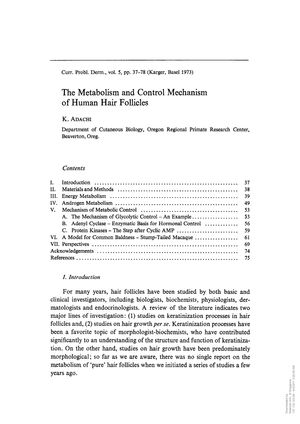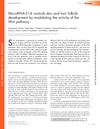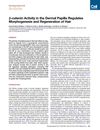The Metabolism and Control Mechanism of Human Hair Follicles
April 2015
in “Current problems in dermatology”

TLDR Human hair follicles have a unique metabolism that changes between growth stages and may contribute to baldness.
The document from 2015 investigates the metabolism and control mechanisms of human hair follicles, with a focus on energy metabolism, androgen metabolism, and metabolic control mechanisms. It was found that hair follicles have a unique metabolism characterized by a dominant Embden-Meyerhof-Parnas (EMP) pathway and significant pentose cycle activity, which varies between growing and resting stages. Growing hair follicles have higher metabolic rates, including a 400% increase in pentose cycle activity and a 200% increase in glucose utilization compared to resting follicles. The study also found that growing follicles metabolize testosterone faster than resting ones, with a greater formation of dihydrotestosterone (DHT), which is the tissue-active androgen. The document also discusses the role of the adenyl cyclase-cyclic AMP-protein kinase system in hair growth and baldness, suggesting that DHT inhibits adenyl cyclase activity, which may contribute to pattern baldness. The stump-tailed macaque was used as a model for human baldness, and the study concludes that this model is suitable for such research. The study suggests that the availability of TPNH during active hair growth stages is a major control factor for DHT production, and that lower cyclic AMP content in hair follicles could lead to premature termination of the anagen stage and contribute to baldness. The research was supported by National Institutes of Health Grants and emphasized the need for further research.
View this study on karger.com →
Related

research Sustained Human Hair Follicle Growth Ex Vivo in a Glycosaminoglycan Hydrogel Matrix
Human hair grows better in a special gel that mimics skin.

research MicroRNA-214 controls skin and hair follicle development by modulating the activity of the Wnt pathway
MicroRNA-214 is important for skin and hair growth because it affects the Wnt pathway.
research Control of hair follicle cell fate by underlying mesenchyme through a CSL–Wnt5a–FoxN1 regulatory axis
Notch/CSL signaling controls hair follicle differentiation through Wnt5a and FoxN1.

research β-catenin Activity in the Dermal Papilla Regulates Morphogenesis and Regeneration of Hair
β-catenin in the dermal papilla is crucial for normal hair growth and repair.